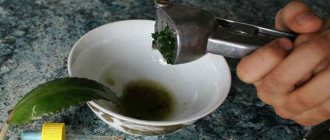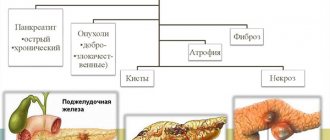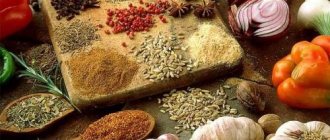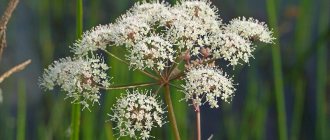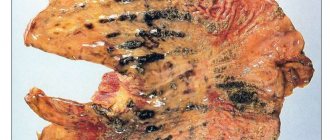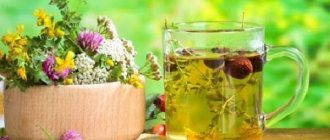With atrophic gastritis, the cells of the stomach walls cease to perform their function, that is, to produce secretion, which is a component of gastric juice. Initially, the glands transform and synthesize mucus, which is unable to aid digestion, and then completely lose their ability to secrete.
Focal atrophic gastritis affects some areas of the mucosa, their “inaction” is compensated by healthy tissue. The antrum develops at the place where the stomach passes into the duodenum and then spreads throughout the organ.
The danger of the disease lies not only in the fact that the process of food digestion is disrupted (this can be easily corrected with the help of medications), but in the fact that the disease can lead to stomach cancer. Cells that have undergone the atrophic process can no longer be restored. But the patient must undergo therapy to prevent the development of the disease.
Treatment should include the destruction of the Helicobacter bacterium, which affects the pathogenesis of the disease, and taking medications to help digest food and relieve inflammation.
Why is treatment with folk remedies recommended?
In addition to basic drug therapy, the doctor may recommend treatment of atrophic gastritis with folk remedies. Since the disease is chronic, it is necessary to constantly stimulate the digestive processes.
Although medications do an excellent job with this task, they have a number of contraindications and can cause side effects. And the components of traditional medicine are practically free of these shortcomings. They can be used for a long time and do not have a negative effect on the excretory system.
For the treatment of atrophic gastritis, substances should be used that:
- decrease or increase the acidity of gastric juice (depending on the diagnosis);
- reduce inflammation in the gastrointestinal tract;
- saturated with vitamins and beneficial elements (to eliminate hypovitaminosis);
- help improve digestion and peristalsis.
Sea buckthorn oil
Sea buckthorn oil has excellent regenerative and anti-inflammatory properties, promotes the healing of wounds, erosions and ulcers, which has earned it high popularity in folk medicine. It is rich in vitamins and microelements.
Popular method: pour 2 teaspoons of sea buckthorn oil into a glass of warm cow's milk. Mix the mixture thoroughly. A glass is drunk in the morning on an empty stomach. The full course of therapeutic effects lasts a month. The sooner treatment with folk remedies is started, the more useful it will be, and the sooner recovery will occur.
Folk remedies that help with atrophic gastritis
Treatment with folk remedies should be agreed upon with the attending physician and carried out after a final diagnosis has been made. During the period of exacerbation of atrophic gastritis, you will need to take medications to quickly and effectively cope with the symptoms. During remission, it is better to adhere to the prescribed diet and carry out a course of therapy using traditional methods to stop the development of the disease.
Traditional medicine recommended for low acidity
If hydrochloric acid levels are low, this leads to the fact that food entering the stomach is poorly digested. In order for the body to absorb microelements such as calcium, magnesium, iron, zinc, copper, selenium, a certain pH level is required; if it is insufficient, then absorption does not occur.
An acidic environment is necessary to neutralize bacteria and yeasts entering the gastrointestinal tract
You can increase the acidity of gastric juice using the following recipes:
- Grind the white cabbage leaves with a blender or meat grinder. The resulting juice should be drunk 30 minutes before a meal. On the first day, drink half a glass of juice, then the dose gradually increases and by the end of the month it is already a whole glass. Course 30 days.
- Take 250 g of blackcurrant berries (you can use fresh or frozen) and pour 500 ml of warm water over them. Bring to a boil, then squeeze out the berries and strain. Drink 200 ml blackcurrant juice in the morning an hour before breakfast for one week.
- Pour boiling water over one tablespoon of dried crushed plantain and leave for ten minutes. It is recommended to drink the decoction three times a day before meals, a third of a glass. Plantain not only increases acidity, but also has an anti-inflammatory effect.
- Pour 20 g of elecampane root with water and bring to a boil. As soon as the water boils, remove from heat and let the broth soak for at least an hour. It is recommended to drink the liquid one spoon per day for 10–14 days.
Read also: Pain due to stomach ulcer
Remedies recommended for high acidity of gastric juice
An aggressive environment provokes pathological changes in the tissues of the stomach, esophagus, and duodenum, which may result in erosion, ulcers, and cancer of the esophagus or stomach. To reduce the acidity of gastric juice, it is recommended to consume the following foods and plants.
Calamus root
It normalizes acidity and relieves heartburn. To prepare the infusion, take one teaspoon of the root and pour boiling water over it, leaving to steep for two hours. You need to drink liquid 5 minutes before a meal.
You can make a tincture from calamus root. For 200 ml of vodka, take 2 tablespoons of crushed root and leave to soak for two weeks. The tincture is also drunk before meals, 4-5 drops.
Honey
It can be consumed in its pure form (4 times a day, 50 grams) during the diet, or you can prepare a tincture. For 200 ml of vodka, take 250 grams of honey and the same amount of Kalanchoe juice. Infuse the liquid for a month. You need to drink one tablespoon on an empty stomach. The course of therapy is up to 25 days.
Sea buckthorn
Plant oil should be taken 1 teaspoon half an hour before meals for one month. It nourishes the stomach cells and reduces inflammation.
Potato juice
Peel and grate the fruit. Squeeze the liquid out of the pulp. Take the juice on an empty stomach, a few tablespoons for 10 days, half an hour before meals. It is better to take a potato variety with pinkish skin.
It is not recommended to store juice; it must be prepared before use.
Medicinal plants
A decoction of plantain leaves, wormwood, immortelle inflorescence, calendula flowers and St. John's wort is useful. The components are taken in equal parts (except St. John's wort, which needs three parts). A spoonful of the mixture is thrown into boiling water and left to simmer on the fire for another quarter of an hour. Drink a third of a glass of the decoction 30 minutes before meals.
Recipes for restoring the gastric mucosa
The most effective folk remedies for the treatment of atrophic gastritis are various herbal decoctions with anti-inflammatory and analgesic effects and freshly squeezed vegetable juices.
Herbal preparations and decoctions:
- A collection of St. John's wort, shepherd's purse and marigold will help restore the gastric mucosa. The grass is taken in the same proportion (about 5 g) and scalded with boiling water. After the infusion has cooled, you can add a spoonful of honey and let it brew for a day. You need to drink 150 ml of the product an hour before meals.
- A decoction of immortelle (10 g), sage (10 g), cinquefoil root (10 g) and cumin (5 g) can relieve painful sensations in the stomach area. All ingredients need to be cooked for half an hour, then allowed to cool and refrigerated overnight to set. Drink 175 ml decoction once a day for 14 days.
- A decoction of rosehip has an anti-inflammatory, restorative, choleretic, and calming effect. To prepare it, you can take both fruits and leaves. The mixture is poured with water and cooked after boiling for 10 minutes. After the liquid has cooled, you can drink it. The maximum benefit from the decoction will be if you consume it an hour before meals. You need to drink for at least 5 weeks 4 times a day.
- Chamomile infusion has anti-inflammatory, bactericidal and regenerating effects. Two tablespoons of dried flowers are scalded with a glass of boiling water. The cooled liquid can be sweetened with honey or sugar.
Read also: Flushing a child’s stomach at home
Drinking chamomile tea after meals will help slow down the atrophic process
Other recipes:
- Dill seeds can relieve stomach pain and aid digestion. The infusion requires a tablespoon of crushed seeds and 2 cups of boiling water. Leave to brew for 2 hours. Drink before meals twice a day.
- An infusion of parsley root helps restore the gastric mucosa. The dried root is crushed and poured with boiling water, left for 30 minutes.
- Flax seeds have an enveloping effect and eliminate heartburn. They are boiled for 10 minutes, then the broth is filtered. Drink no more than 100 ml of liquid on an empty stomach per dose.
- The following recipe will help eliminate pain and relieve inflammation. For the herbal collection you will need 3 tablespoons of dried black elderberry flowers and the same amount of chamomile, 2 tablespoons each of lemon balm and mint and one spoon of linden flowers and fennel fruits. Throw a tablespoon of the resulting mixture into boiling water and cook over low heat for 10 minutes. Leave to sit for two hours. Drink a third of a glass between meals.
- The following traditional medicine recipe will help relieve inflammation and get rid of the symptoms of atrophic gastritis. Mix equal amounts of honey, aloe juice and butter. Eat the resulting mass one tablespoon approximately half an hour before meals. The course of therapy is two weeks, then a break is needed. Repeat if necessary.
Beetroot juice will help prevent the development of stomach cancer. You need to drink it diluted with an equal amount of water. For atrophic gastritis, drink twice a day before eating.
Oat infusion
Oats have long been considered an excellent folk remedy for treating all disorders affecting the digestive system. It is used for the prevention of atrophic hypoacid conditions of the stomach, for treatment. A special infusion is prepared from oat grains to treat chronic gastritis. You will need to grind the grains, not to the consistency of flour. 2 tablespoons of the resulting powder are poured with 400 milliliters of boiling water and the mixture is allowed to brew. The optimal solution would be to place the mixture in a thermos for 5-6 hours.
When the resulting decoction is thoroughly infused, it is filtered and taken twice a day before meals. You will need half a glass per serving. The course of therapy continues for a month. Taking it regularly, patients feel improvement within the next few days.
Diet for atrophic gastritis
To avoid further development of atrophic gastritis, it is important not only to take medications and use folk remedies, but also to adhere to certain rules. It is malnutrition that becomes the root cause of all pathological processes occurring in the stomach.
For atrophic gastritis, it is recommended to adhere to the following recommendations: food should be warm. Too hot can injure the mucous membrane of the esophagus and stomach.
It is important to eat small meals. This means that you need to eat in small portions, but often (6-8 times a day). This way you can avoid the unpleasant symptoms of gastritis that occur after a meal (feeling of heaviness, bloating, rumbling).
The intervals between meals should be the same; it is better to eat on a schedule. It is recommended to consume only fresh products that have undergone high-quality temperature treatment. With atrophic type gastritis, it is forbidden to eat fried, smoked, pickled, salty, spicy foods. Alcoholic drinks and smoking should be avoided.
Read also: Pain in the right hypochondrium radiating to the back
If you do not change your eating habits and addictions, you will have to wait a very long time for the effect of treatment
The term diet implies some restrictions associated with the intake of certain foods. With atrophic gastritis, many products are prohibited. One of the doctors' recommendations is to avoid unprocessed vegetables and fruits. However, there are fruits and berries that doctors recommend consuming.
These include bananas, blueberries and apples. Bananas contain many useful vitamins and microelements and help relieve inflammation of the gastrointestinal tract. It is recommended to eat it after meals. Blueberries have restorative properties. You should eat it fresh, 1 teaspoon in the morning before meals.
A green apple should be eaten pureed on an empty stomach. You can prepare a dessert from 200 g of apples, 0.5 kg of pumpkin, 50 ml of lemon juice and a tablespoon of honey. Grind the apple and pumpkin into a paste, add lemon juice and honey. Eat in the morning.
What foods should you not eat if you have gastritis?
All products can be divided into acid-forming and alkali-forming. Studies show that if a patient has increased stomach acidity and refuses acid-forming foods, then the symptoms disappear after a two-week diet.
This means that a balanced diet will help prolong the remission stage and significantly slow down the atrophic processes occurring in the tissues of the gastric mucosa. Products that can increase the acidity of gastric juice:
- spices;
- bright fruits and sour juices;
- coffee, chocolate;
- pickled;
- high fat animal products;
- roast;
- alcohol;
- tomatoes, apples;
- onion garlic;
- foods containing a lot of sugar.
Eating cereals is a mandatory stage of diet therapy.
Foods containing potassium, magnesium, calcium, and sodium reduce acidity. But their excess can have a bad effect on the body as a whole. There is a daily need for these elements. You can lower the pH by eating porridge, boiled, stewed or steamed vegetables, non-acidic apples, pears, bananas, dietary meat and fish, cottage cheese, cream.
If atrophic gastritis is diagnosed, then the patient must not only change his diet for some time, but completely eliminate some foods, regardless of the stage of the disease. This will help get rid of unpleasant symptoms and slow down the atrophic process. It is also useful to start new habits, for example, replacing coffee with chamomile or rosehip tea.
Folk recipes based on calamus roots
Calamus is a plant that increases the secretion of hydrochloric acid in the stomach. It contains a lot of ascorbic acid, essential oils and gum. There are several recipes for traditional healers based on calamus roots.
- A special medicinal tincture is prepared from crushed calamus rhizomes. 20 grams of rhizome are infused with 100 grams of vodka. Exposure time – 2 weeks. The tincture is filtered and pressed. The finished product should be stored in a dark, cool place. To cure atrophic gastritis of the stomach, 15 drops of tincture are drunk before meals.
- The water infusion is prepared as follows: crushed calamus rhizomes in the amount of one teaspoon are poured into a glass of boiling water. The resulting product must be infused for 20 minutes. You need to drink half a glass.
- Calamus root can be added to a medicinal mixture: 10 grams of calamus roots, 10 grams of wormwood herb, 10 grams of three-leaf watch, 10 grams of caraway fruits.
Benefits of bananas
The fruit has an enveloping property and relieves irritation. Therefore, it is indicated for use in many diseases of the digestive tract. Banana has a soft consistency, so it passes through the inflamed walls of the esophagus, stomach and intestines without damaging them. It can be used in food in any form, at least once a day. Its use is especially effective when painful sensations occur.
Prevention
To prevent the appearance of atrophic gastritis, it is necessary to promptly treat the pathologies that precede it - acute, chronic gastritis.
Prevention involves the following measures:
- eliminate smoking and alcohol;
- promptly treat infectious diseases;
- eat healthy and balanced;
- perform personal hygiene (before eating, be sure to wash your hands and use individual utensils);
- avoid stress and physical strain.
If a patient has atrophic gastritis, the doctor determines the symptoms and treatment with medications and folk remedies. The patient is worried about heaviness and pain in the stomach, rumbling. Traditional recipes will effectively cope with such manifestations and help normalize the patient’s condition.
Forms of pathology
Atrophic gastritis can be divided into the following forms:
- Spicy. There is an exacerbation of the chronic course of the disease.
- Chronic. It is an independent disease, and not a prolongation of acute gastritis. It is in remission or simply inactive.
- Focal gastritis. Foci appear on the walls of the stomach, where the tissue is deformed.
- Antral. Destructive processes affect exclusively the antral region of the organ.
- Surface. This gastritis becomes a harbinger of inflammation of the stomach.
- Moderate. Here the conversion level is easy or partial. Basically, dyspeptic disorders occur.
- Diffuse gastritis. There are no serious dystrophic disorders.
Treatment should involve the elimination of the Helicobacter bacterium, which affects the onset of the disease, and the use of agents that promote food digestion and eliminate inflammation. Treatment with folk remedies is no less effective.
Juice therapy
Gastroenterologists and nutritionists recommend using juices that have medicinal properties. They contain plant fibers that improve digestive function and eliminate the inflammatory response. The multivitamin composition helps strengthen the immune system and enhance the regeneration of damaged tissues. Therefore, the body can fight the disease on its own.
Some types of juices can harm the stomach, so you should first consult a gastroenterologist.
Juices that reduce acidity:
- pomegranate;
- apple;
- tomato
Juices that increase acidity;
- potato;
- pumpkin
Juices with neutral pH:
- aloe;
- salad;
- beet.
Often, freshly squeezed juices can harm inflamed stomach walls, so they are not recommended. A canned product will do. You can take several varieties, mixing with each other.
Herbal tea No. 2
To prepare the mixture, you need to take the following components (40 g each):
- dried dill;
- mint and sage leaves;
- angelica and calamus root;
- dried herbs St. John's wort, eyebright, immortelle, wormwood.
The herbs are thoroughly mixed and placed in a closed container. Each time take 1 tbsp from there. l., which is poured with 200 ml of boiling water. Leave until completely cooled. Drink 100 ml in the morning and evening, before each meal. The course of therapy is at least 3 months, after which a positive result will appear.
Symptoms
Atrophic gastritis is often preceded by another form of this pathology. After the inflammatory process of the gastric mucosa under the influence of pathogenic bacteria (Helicobacter microbe) or improper nutrition, its transformation occurs. One or even more atrophic foci appear on the walls of the organ. Also, the cause may be heredity, experienced infectious pathology, chronic intoxication.
Atrophy of stomach cells leads to a decrease in the production and release of hydrochloric acid. Irreversible processes lead to anemia and hypovitaminosis, which significantly reduces the immune system.
The person experiences abdominal pain and discomfort. The following signs of the disease occur:
- constant heartburn, belching;
- bowel dysfunction;
- nausea, loss of appetite;
- bloating;
- bad breath;
- in the acute stage - coated tongue.
At the last stage of development, without proper treatment, the disease can provoke gastric bleeding.
If chronic atrophic gastritis is treated in a timely manner, its progression to cancer can be avoided.
To do this, you need to follow a diet, use medications and folk remedies prescribed by a doctor.
Dill seeds
A decoction prepared from this product is used. It is even recommended for children, because it has good healing properties for inflammation of the stomach. To prepare the product, it is recommended to follow the following recipe:
- 1 tsp. seeds are placed in a container;
- add 200 ml of water, place in a water bath;
- Boil for 2-3 minutes after boiling.
The resulting drink must be cooled and strained. Drink it before meals, 2-3 times a day. Therapy can be continued until the painful symptoms disappear.
Cumin seeds
Cumin is added to various dishes to enhance the taste and medicinal effect. The seeds improve appetite, which is often reduced due to illness. In addition to food, recipes for caraway decoctions are also used:
- put 2 tbsp. l. in a large container;
- add 350 ml of water, boil;
- Infuse the product for several hours, then strain.
The treatment course is 30 days, take 250 ml of the product per day. This will eliminate inflammation of the stomach walls and improve local and systemic blood circulation.
